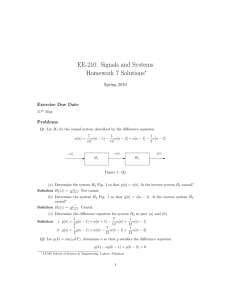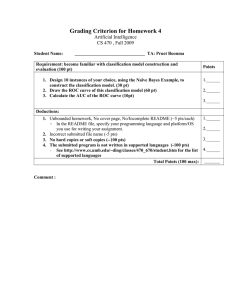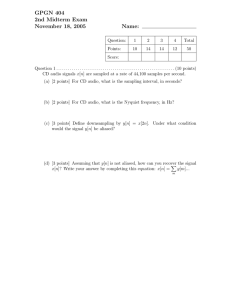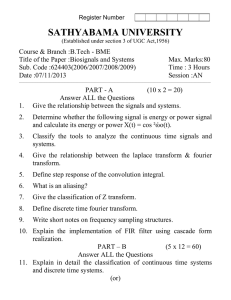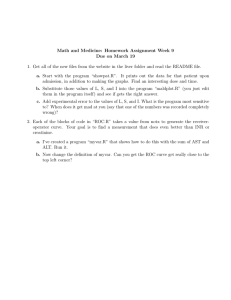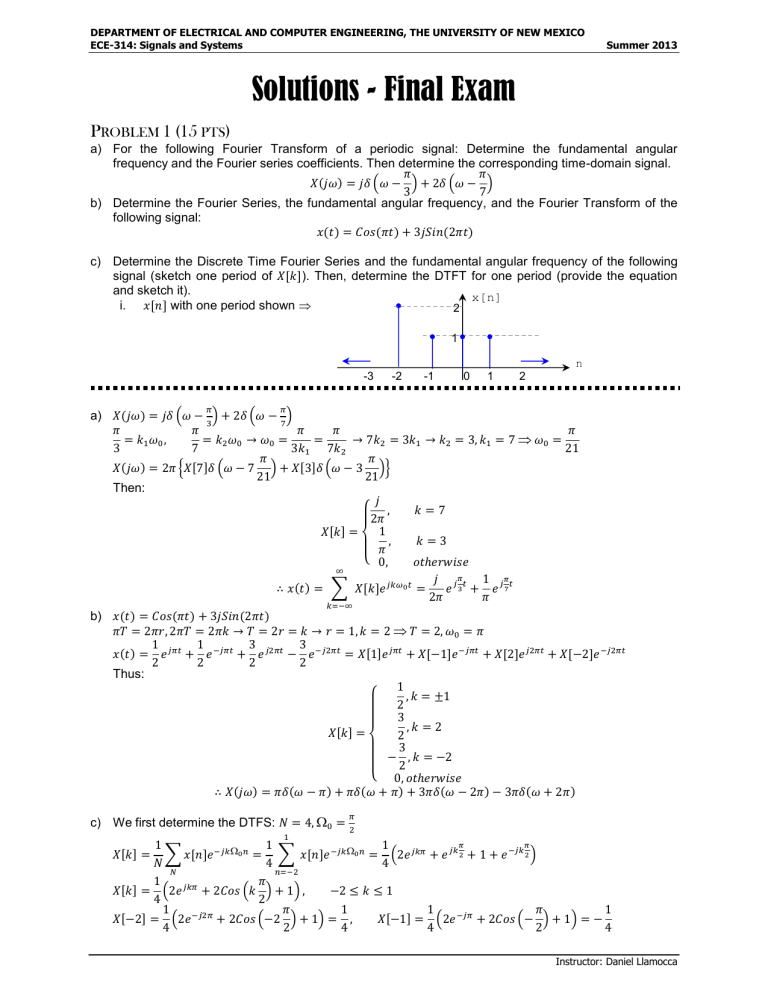
DEPARTMENT OF ELECTRICAL AND COMPUTER ENGINEERING, THE UNIVERSITY OF NEW MEXICO
ECE-314: Signals and Systems
Summer 2013
Solutions - Final Exam
PROBLEM 1 (15 PTS)
a) For the following Fourier Transform of a periodic signal: Determine the fundamental angular
frequency and the Fourier series coefficients. Then determine the corresponding time-domain signal.
b) Determine the Fourier Series, the fundamental angular frequency, and the Fourier Transform of the
following signal:
c) Determine the Discrete Time Fourier Series and the fundamental angular frequency of the following
signal (sketch one period of
). Then, determine the DTFT for one period (provide the equation
and sketch it).
x[n]
i.
with one period shown
2
1
n
-3
-2
-1
0
1
2
a)
Then:
b)
Thus:
c) We first determine the DTFS:
Instructor: Daniel Llamocca
DEPARTMENT OF ELECTRICAL AND COMPUTER ENGINEERING, THE UNIVERSITY OF NEW MEXICO
ECE-314: Signals and Systems
Summer 2013
Finally, over one period:
X[k]
X(ej )
5p/2
5/4
1/4
-3
-2
-1
k
0
1
-p/2
-p
2
-1/4
p/2
-p/2
p/2
0
PROBLEM 2 (12 PTS)
Determine the Laplace transform (or Z transform) and the ROC for each of the following signals:
a)
.
Use the definition of the Laplace Transform. Sketch the pole-zero plot. What is the condition on
the Fourier Transform to exist?
b)
.
c)
. What is the condition on for the Z-transform to exist?
for
a)
Im
Re{s}>a
Re
is integrable if
For the FT to exist, we need
a
(so that the
axis is included in the ROC)
b)
We know:
c)
We know:
For the Z-Transform to exist, we need
.
Instructor: Daniel Llamocca
DEPARTMENT OF ELECTRICAL AND COMPUTER ENGINEERING, THE UNIVERSITY OF NEW MEXICO
ECE-314: Signals and Systems
Summer 2013
PROBLEM 3 (10 PTS)
For an LTI system, we are given the Z-transform of the input and output signals:
a) Determine the impulse response
. Sketch it. (7)
b) Determine the DTFT of
. (2)
c) What is the region of convergence of
? Sketch the DTFT on the z-plane. (1)
a)
h[n]
Im
1/2
1/4
...
-1
b)
c)
...
0
1
2
is undefined if
3
4
5
Re
1
n
6
. Thus, the ROC is the entire z-plane except for
.
PROBLEM 4 (15 PTS)
a) For the following Laplace Transform, determine all possible time-domain signals. Hint: First determine
all possible ROCs. (8)
b) For the following Z-transform, determine
(for
and
) so that the DTFT exists. (7)
a)
We know:
or
Assuming
or
: Three possible ROCs:
b)
We know:
Possible ROCs for
:
Instructor: Daniel Llamocca
DEPARTMENT OF ELECTRICAL AND COMPUTER ENGINEERING, THE UNIVERSITY OF NEW MEXICO
ECE-314: Signals and Systems
For
: We need the unit circle inside the ROC:
Thus:
For
: We need the unit circle inside the ROC:
Thus:
PROBLEM 5 (16 PTS)
For the following LTI system with
a)
b)
c)
d)
Summer 2013
h[n]
causal.
x[n]
Find the difference equation that relates
and
. (2)
S
Determine
, the ROC, and the pole-zero plot. (3)
Determine the impulse response
. (3)
For the input
: (8)
i. Determine
, the region of convergence, and the pole-zero plot.
ii. Determine
. What is the condition on and so that the DTFT of
y[n]
S
b
exists?
a)
b)
Here, we use a well-know transform along with the fact that
is causal:
Im Example: |b| >1
1 b
Re
c)
d)
Im
Example: |a|<1
1 a
Re
Now, to get
:
We know:
For the DTFT of
to exist, the unit circle needs to be inside the ROC. Thus, we need:
Instructor: Daniel Llamocca
DEPARTMENT OF ELECTRICAL AND COMPUTER ENGINEERING, THE UNIVERSITY OF NEW MEXICO
ECE-314: Signals and Systems
Summer 2013
PROBLEM 6 (10 PTS)
a) For an LTI system with
. Is the system stable?
b) An LTI system has
. What is the condition on so that the system is stable?
c) For an LTI system with
:
i. If the system is causal, determine the ROC. Does the FT of
exist? Justify.
ii. If the system is stable, determine the ROC. Is the system causal? Justify.
d)
. If
is causal, is the system stable? Justify.
e) Given that
. Is the system stable? Justify.
a) The system has a pole at
. As a result, the
axis (which is the FT) is not included. As the
existence of the FT implies stability, the system is not stable.
b) We need the ROC to include the
axis. For
, the ROC does not exist. For
, the
axis is not included. For
, the
axis is always included. Thus, we need
.
c)
: There are three possible ROCs.
,
,
i. If the system is causal, the ROC is to the right of the rightmost pole, i.e.,
. The
axis
is not included. Thus, the FT of
does not exist.
ii. If the system is stable, the ROC has to include the
axis. Thus:
. Since the
ROC is not to the right of the rightmost pole, the system is not causal.
d) If the system is causal, then the ROC is outside of the outermost pole, i.e.,
. In this case, the unit
circle is not included in the ROC, and thus the system is not stable.
e)
. There is a pole at
. Thus,
the system is not stable.
PROBLEM 7 (12 PTS)
a) For the following signal:
(6)
i. Determine the Fourier Series and the fundamental angular frequency. Determine the Fourier
Transform and sketch it.
ii. Sketch the FT of the sampled signal for
. Indicate the cases that result in
aliasing. What is the condition on to avoid aliasing?
b) For the following speech signal: (6)
i. Sketch the FT of the sampled signal for Ts = 0.05, 0.1,
and 0.2ms. What is the condition on to avoid aliasing?
ii. We want to transmit this signal over a channel that only
allows frequencies from 200 Hz to 3.2KHz. Sketch the FT
of the system that allows proper transmission of the given
speech signal. For the new band-limited signal, what is
the condition on that avoids aliasing when sampling?
|X(jw)|
1
w
-10000p
10000p
a)
X(jw)
6p
Thus:
2p
p
-p/2 -p/4
w
0
p/4 p/2
Instructor: Daniel Llamocca
DEPARTMENT OF ELECTRICAL AND COMPUTER ENGINEERING, THE UNIVERSITY OF NEW MEXICO
ECE-314: Signals and Systems
Summer 2013
X(jw)
(aliasing occurs)
6p
2p
p
-p/2 -p/4
...
w
p/4 p/2
0
(aliasing occurs, this is the limit case)
X(jw)
6p
2p
p
-p
-p/2 -p/4
w
p/4 p/2
0
p
To avoid aliasing:
b)
,
,
TS = 0.05ms
1
|X(jw)|
...
...
-40000p
-10000p
10000p
TS = 0.1ms
1
w
30000p 40000p
|X(jw)|
...
...
-20000p -10000p
w
10000p 20000p
TS = 0.2ms
1
|X(jw)|
...
...
-10000p
w
10000p
To avoid aliasing we need:
To allow transmission over a band of 200 - 3200Hz, i.e. from
, we need the following filter:
H(jw)
1
-6400p
The new
400p
6400p
w
. Thus, the condition to avoid aliasing when sampling is:
Instructor: Daniel Llamocca
DEPARTMENT OF ELECTRICAL AND COMPUTER ENGINEERING, THE UNIVERSITY OF NEW MEXICO
ECE-314: Signals and Systems
Summer 2013
PROBLEM 8 (10 PTS)
c) For the following signal:
and for Full Amplitude modulation: (6)
i. Get the Fourier series and the Fourier Transform of
. Sketch the Fourier Transform of
(the message) and of the modulated signal.
ii. Provide an expression for the percentage of modulation based on . What is condition on
avoid over-modulation? Find the value of
that provides a % of modulation of 45%.
d) The following signal needs to be transmitted alongside others
(Full AM). However, there is only an allowable band for the signal.
Thus, we need to filter some frequencies. (4)
i. Sketch the FT of the system that filters these frequencies.
ii. What is the carrier frequency (in Hz) that allows for this
signal to be properly transmitted?
iii. What is the condition on
to avoid over-modulation?
S(jw)
to
M(jw)
1
w
-2000p -1000p
1000p 2000p
Allowable band
w
-3000p -wCA -1000p
-2000p
-6000p
1000p wCA 3000p
2000p
wCC
wCD
a)
S(jw)
3p
pAC
M(jw)
pkaAC3/2
w
w0
w0
w
-wC -w0 -wC
-wC +w0
wC -w0
wC wC +w0
-pkaAC
-2p
Percentage of modulation:
To avoid over-modulation:
For 45%:
b) Allowable band:
. So,
Then, we need the following filter:
.
H(jw)
1
-1500p
According to the graph, the carrier frequency should be:
To avoid over-modulation:
w
1500p
.
Instructor: Daniel Llamocca
DEPARTMENT OF ELECTRICAL AND COMPUTER ENGINEERING, THE UNIVERSITY OF NEW MEXICO
ECE-314: Signals and Systems
Summer 2013
BONUS PROBLEM (+ 10 PTS)
a) Using the definition, determine the Laplace Transform, the ROC and the pole-zero plot of the
following signal:
. (2)
b) Demonstrate that if the ROC of the Z-transform of the impulse response of an LTI system contains
the unit circle, then, the system is stable. (2)
c) Consider a signal with Laplace Transform
. Determine a different Laplace Transform
and the corresponding time function
, so that: (2)
d) A pressure gauge, which can be modeled as an LTI system, has a time response to a unit impulse
input given by
. For a certain unknown input
, the output is observed to be
. For this observed measurement, determine the true pressure input to the
gauge as a function of time. Assume that the input signal is right-sided. (4)
Im
a) T > 0:
...
2p/T
Re
a
Pole:
Zeros:
...
There is one zero at
. As a result, there is pole-zero
cancellation. Thus, the ROC is the entire s-plane.
b) If the ROC includes the unit circle, that means that the DTFT exists or converges.
Convergence of DTFT:
Definition of stability for LTI systems:
We notice that these two definitions are the same, therefore convergence of the DTFT of
stability of the LTI system.
implies
c)
. This can correspond to:
Now, we know that
. For FT to exist, we need
Thus,
d)
Since we know that
is right-sided, then the ROC has to extend toward infinity.
Finally:
Instructor: Daniel Llamocca

